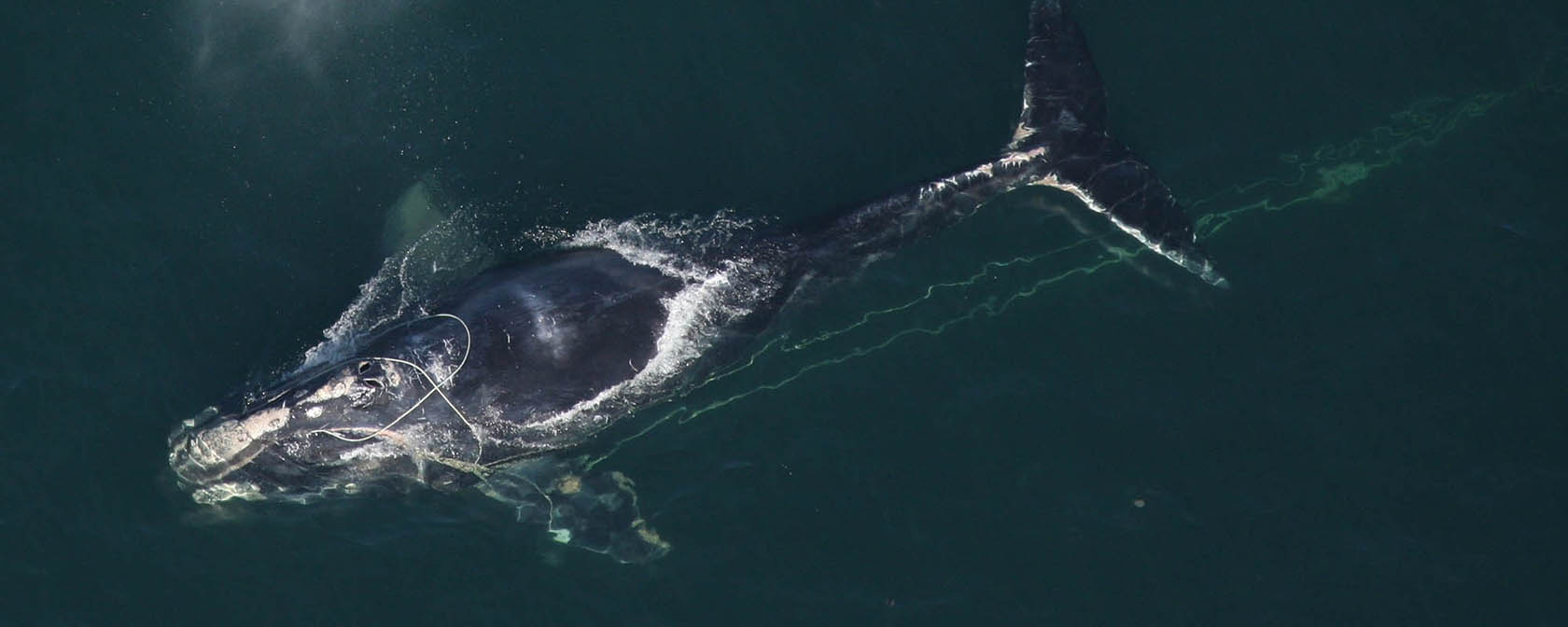By Sara Amundson and Kitty Block
Our National Marine Fisheries Service, slow to take action, really shouldn’t need a prompt about the fierce urgency of now when it comes to protecting the critically endangered North Atlantic right whale. Still, a new reminder has come with the tragic sighting last week of a four-year old male badly injured and entangled in fishing lines about two and a half miles off the coast of Sea Bright, New Jersey.
Last seen in the Gulf of St. Lawrence in July, healthy and free of crippling lines or gear; the whale, known to researchers as #4680, is in extremely poor condition with numerous observable injuries caused by heavy entangling commercial fishing lines. He’s the son of a whale named Dragon, observed in late February off Nantucket with a buoy lodged in her mouth, and presumed dead.
Marine mammal specialists are trying to organize a rescue and relief mission for #4680, but things don’t look good for this whale right now.
This is reminiscent of last June’s discovery of the body of a dead North Atlantic right whale calf floating off the coast of New Jersey—a victim of two boat strikes, according to preliminary analysis. There are just 400 of these marine mammals left in our oceans. Since 2017, only 22 North Atlantic right whale calves have been born, with more females than males having died and because more females are giving birth later and with longer inter-birth intervals. A documented 31 North Atlantic right whales have died and an additional 10 are presumed dead due to the serious nature of injuries sustained. That brings the total to 41 likely dead in the past three years.
Once a prized target of whaling fleets, right whales are being driven toward extinction by the twinned threats of being struck by ships and complex entanglement in heavy commercial fishing gear and fishing lines. What humanity refused to let nineteenth and twentieth century whaling fleets do, inaction by the U.S. government and other parties is threatening to accomplish. Where the causes of death in right whales over the last several decades can be determined, the vast majority are a result of entanglement in fishing gear and lines.
This summer, the HSUS and other organizations prevailed in litigation to force the NMFS, a division of the National Ocean and Atmospheric Administration, to take long-overdue steps to protect right whales from fatal entanglements in heavy lobster-fishing gear. The judge in the case set a firm deadline for the agency to finalize regulations to reduce the risk of entanglements. With some of the same partners, we’ve just petitioned the agency to expand the area and seasonal time periods south of New England in which vessels are required to slow their speeds to reduce the likelihood of fatal collisions.
Finally, in the wake of the International Union for Conservation of Nature’s uplisting of the right whale from “endangered” to “critically endangered,” hundreds of scientists throughout the world have signed an unprecedented statement of concern about whale, dolphin and porpoise conservation.
We need all of this, but more than anything else we need a genuine commitment from the United States and other nations to do what is necessary to save the right whale. The solution to right whale conservation is simple. We must prioritize reducing vessel strikes and entanglement in fishing gear and lines. We must encourage much greater financial support for marine mammal rescue networks, which are essential to emergency response programs designed to free and support the survival of entangled whales at sea.
Back in July, the Congress approved an amendment that would provide an additional $1.5 million to the Department of Commerce (on top of the $5 million already in the base bill) for research and monitoring of these whales to help reduce entanglements and vessel collisions, both among the chief causes of mortality.
But the Congress can do still more. The SAVE Right Whales Act (S. 2453/H.R. 1568), introduced by Senator Cory Booker, D-N.J., former Senator Johnny Isakson, R-Ga, and Reps. Seth Moulton, D-Mass. and John Rutherford, R-Fla., is intended to meet the threat to these remarkable creatures with even more dedicated resources. The bill would authorize $5 million per year over the next decade for research designed to ensure that fishing and shipping interests develop the technology to safely share the ocean with right whales.
We need that bill, and you can help by contacting your two U.S. Senators and U.S. Representative to communicate your support.
But we also need a stronger investment of effort and resources from shipping interests, the fishing industry, and other key stakeholders whose conduct will ultimately determine the fate of the world’s most endangered species. Research suggest that right whales can live to 70 years of age, but under the current circumstances, none are getting the chance to come even close to that. They deserve a future, and it’s up to us to take the actions necessary to prevent their extinction.
Kitty Block is President and CEO of the Humane Society of the United States.




